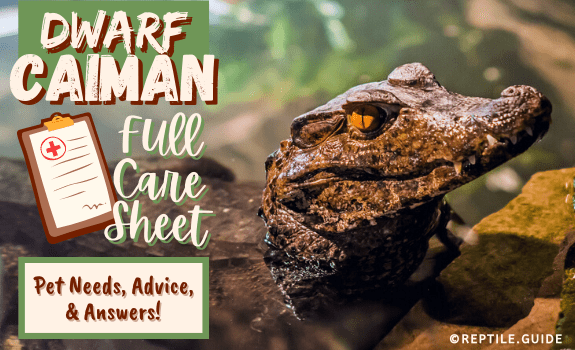The dwarf caiman, Paleosuchus palpebrosus is the alligator family’s smallest and most primitive species.
It’s an unusual and entertaining pet, but it’s not suitable for the average pet owner.
This dwarf caiman care sheet will take a closer look at keeping these animals and meeting their needs.
In This Article
Dwarf Caiman Background Information
The dwarf caiman is also known as the ‘wedge head caiman’. The name ‘Cuvier’s Smooth-fronted caiman’ is after the zoologist who discovered them.
Paleosuchus is a combination of the Greek word palaios – ‘ancient’ and the word soukous – ‘age’. Palpebrosus in Latin translates to bony eyelid.
Opinions about this interesting species vary throughout the world! In Brazil, hunters target caimans for their bones and fat (which are used medicinally).
In areas like the US, the comparatively small dwarf caiman size has made it a popular pet. In America, it’s even possible to buy a caiman online!
Potential buyers must fully understand their behavior, requirements, and expenses.
Cuvier’s dwarf caiman, like the ‘Caiman lizard’, are NOT suitable pets for the average reptile enthusiast!
It’s worth noting that a caiman’s strength doesn’t correlate to its size. They’re much stronger than they look!
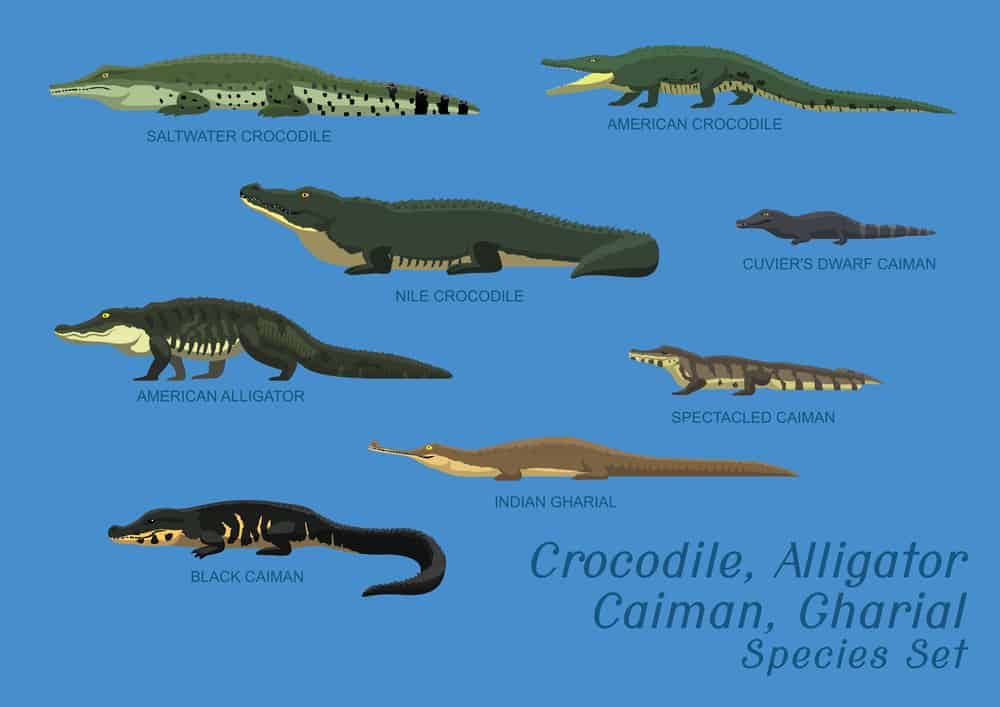
Dwarf Caiman in the Natural Environment
Dwarf caimans are a well-known and important ‘keystone species’ in their natural habitat.
They’re important predators of species like piranhas. This species maintains an ecosystem structure just by eating!
In South America, Cuvier’s dwarf caiman is found in small groups. Like other members of the alligator family, they communicate via their senses.
Examples of such communication consist of:
- Hearing
- Grunting
- Smelling
- Touching
This species lives in hierarchies, and the most aggressive adult is the dominant one.
As ambush predators they don’t actively hunt their food. Caimans prefer to wait for food to come within easy reach. This approach means that they spend less energy on hunting.
In the wild, adults and young both feed on insects and other small animals that live in the water or on the shoreline.
Examples include:
- Frogs
- Crustaceans
- Small fish species
- Terrestrial vertebrates
Fully developed adults also feed on small mammals.
Fun Fact: Caimans have VERY strong stomach acid and small stones (called ‘gastroliths’) in their stomachs. This means that they can swallow their prey whole.
If these animals face a lot of competition from other individuals (for territory or food) they’ll happily migrate long distances.
Scientific studies have also observed burrowing behavior in this species.
They construct burrows of between 1.6 and 11.5 feet in length. The entrance is typically located between the roots of trees.
Caimans are nocturnal and use the dark to remain undetected by their prey. In daylight hours, you’ll find them basking or sitting in shallow water.
The IUCN (International Union for the Conservation of Nature) lists caimans in the category of ‘least concern’.
This means that they’re common, and not at risk of becoming endangered. Pollution, mining, and habitat destruction can endanger this current status.
If you’re interested in other crocodilians, take a look at our alligator vs. crocodile comparison.
Description
Adult individuals have a darker red-brown color than younger individuals. Males can grow to just over five feet and females grow up to just under four feet.
Juveniles have black encircling bands marking their brown exterior.
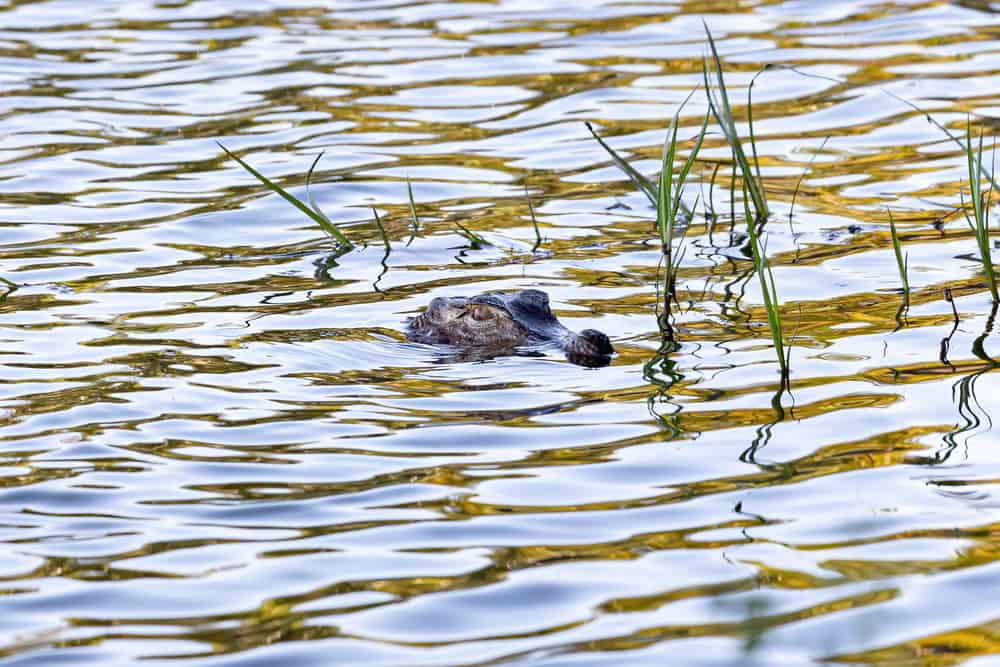
They have an outer layer of bony plates (osteoderms). These plates act as protective armor when swimming in fast-moving streams.
Scientists have proven that dwarf caimans have the largest number of osteoderms. They periodically shed these bony plates.
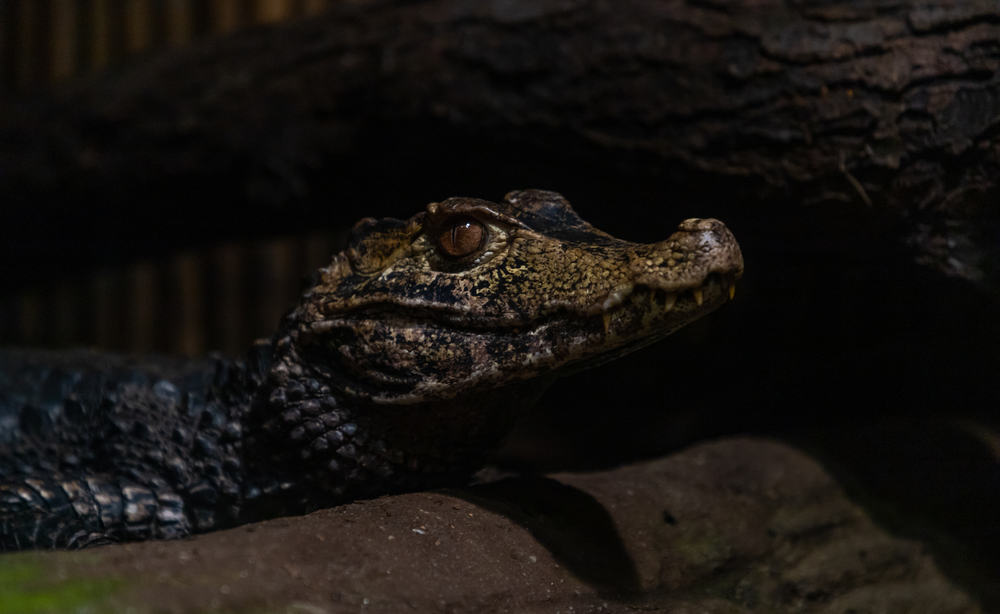
They have special sensory organs in their body to detect movement. It’s normal to see their teeth even when their mouths are closed!
Dwarf caimans have an upturned snout, and the lower jaw overlaps the upper jaw.
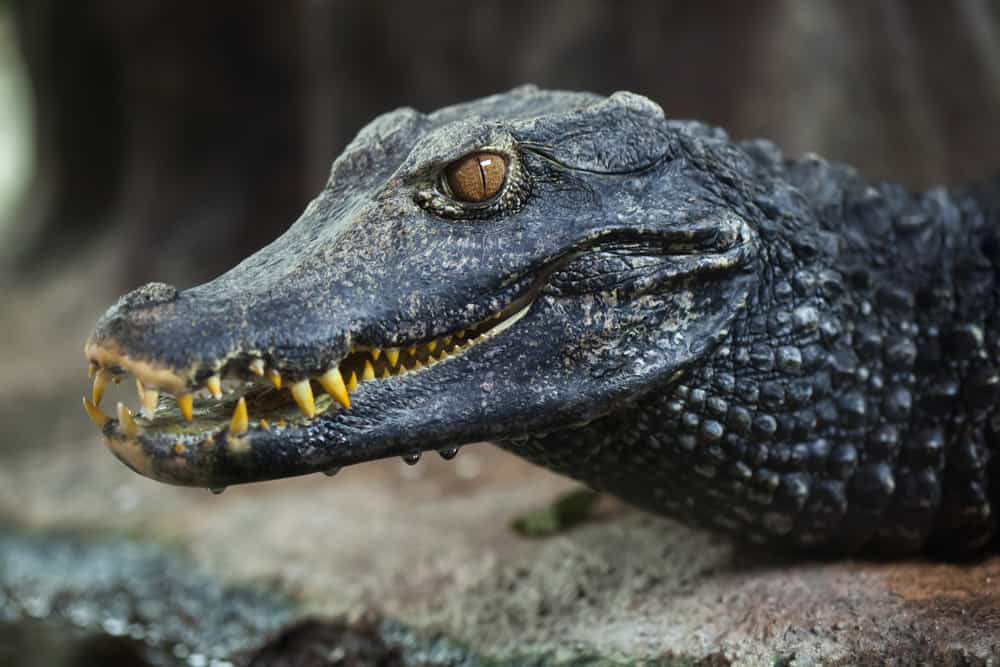
Fun Fact: Caimans have sensitive hearing. They can hear noise from unborn offspring inside the egg!
Habitat
In the wild, dwarf caimans have a distibution that includes 11 countries in Northern and Central South America. Their range includes southern Brazil and the upper Rio in Paraguay.
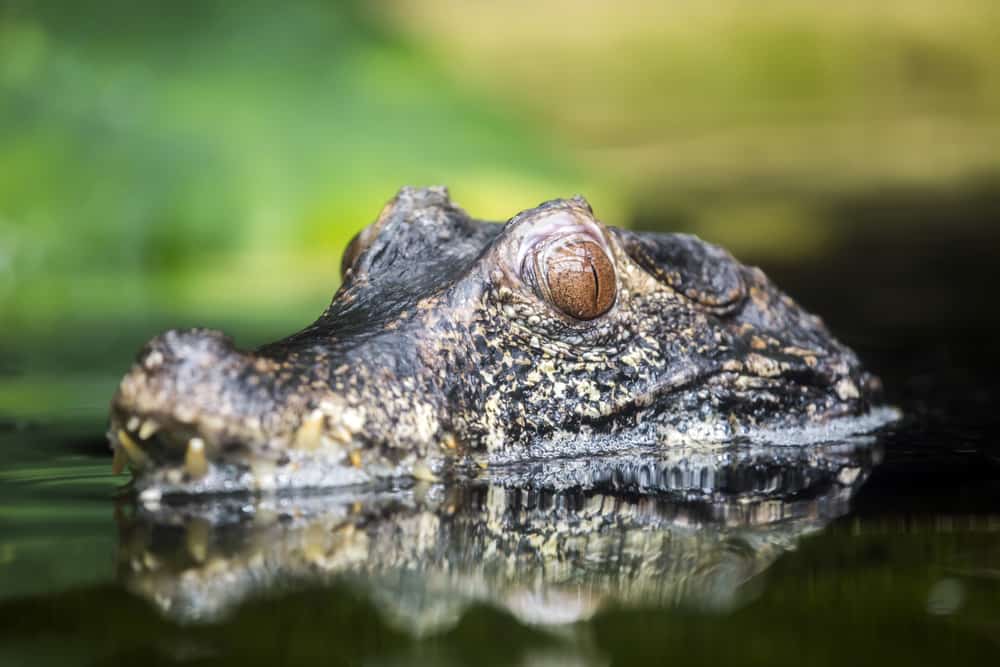
Caimans are very strong swimmers, and even swim against water currents. They can reach speeds of close to 50 km per hour when swimming.
Environmental pollution, habitat destruction, and activities like hunting present the biggest risk for them.
Fun Fact: Cuvier’s dwarf caiman is more tolerant of cooler water temperatures than other members of its family.
Predators of caimans include:
- Boas
- Jaguars
- Anacondas
- Other crocodilian species
Lifespan
Dwarf caimans have a lifespan of roughly 25 years in the wild. In captivity, they live for 35 to 40 years.
Sexual maturity correlates to size, age, and growth. Females can breed when they’re 3.2 feet long and males at 3.6 feet.
They can take more than 10 years to reach reproductive maturity.
Males ‘roar’ and mate with multiple females after a nocturnal courtship display at the end of the dry season. In the wild, females can only breed once per year.
Both parents help to make nests from material gathered in forested areas. Females lay 10-25 eggs in each batch.
Each elongated white egg weighs around 2.5 ounces.
The eggs are a source of food for other species. Both parents exhibit defensive behavior like tail and head-slapping to protect the nest.
After a gestation period of between four and five months, the young hatch. Newly hatched offspring have a protective layer of mucus which prevents the growth of algae.
The gender of the hatchlings is a result of the temperature during gestation. You can judge the gender of dwarf caimans by their size.
Wild females often protect their offspring until the hatchlings disperse (around 21 months after hatching).
Besides color, newly hatched individuals look like adults.
They grow 2.4 to 3 inches per year during the first five years, and grow fastest during the first two.
Fun Fact: People believe that twin caimans represent complementary aspects of nature such as the sky and the earth.
Are Dwarf Caimans Aggressive?
Dwarf caimans have a reputation for hostility.
They’re NOT comfortable when being handled.
It’s important to note that their bite is VERY painful. It’s very difficult to open their jaws once they have closed.
Caimans AREN’T suitable for households with small children. Caiman owners should have experience with correct handling, feeding, and safety.
Caimans often fight with other individuals. They DON’T bond well with humans and never become tame.
The IUCN states the following reasons for the aggression crocodilians show towards humans:
- Hunger
- Defense of territory
- Defense of the young
- Feeling threatened by another species (domesticated animal)
Generally, they prefer to flee danger and become aggressive when they’re unable to escape.
Are Dwarf Caimans Legal?
Each state and county has different regulations regarding their legality. In some, a license is needed and in others, they’re classified as dangerous animals.
You must research the legislation relating to your area before you buy.
Owners must be aware of the legal accountability of their animals for public injuries and damage.
If a license is required, you may need to prove that you have the following:
- Competence in handling
- Knowledge of husbandry
- Appropriate accommodation
- Extensive experience with dangerous reptiles
Dwarf Caiman Care
The dwarf caiman’s size, long life expectancy, and behavior means that only experienced keepers should have them.
They need a custom enclosure and a dedicated owner with vast reptile experience to ensure all-around safety.
A pet caiman is a huge responsibility. You need lots of commitment to ensure they live a humane and fulfilled life.
For safety, welfare, practicality, and conservation reasons, we don’t recommend buying caimans unless they’re part of an adequately equipped rescue center.
Dwarf caimans (especially younger individuals) will escape if possible. Use tall tanks without objects they can use as ‘stairs’ to escape.
Enclosures must be able to withstand the strength of their inhabitants.
Dwarf Caiman Enclosure
Caimans need a large area of water in a secure facility. Enclosures come in a variety of sizes and are most often made of glass.
Adults should have an enclosure of at least 15 feet (length) by 8 feet (width). For inspiration to help you build the perfect enclosure, check out our DIY enclosure plans.
Their enclosure should be half water in which they can swim and half land.
You must have a water filtration system within the recommended 55 to 100-gallon aquarium (40 gallons for hatchlings).
Veterinarians advise using more than one filter medium. The water in the tank should allow total immersion, and you should change it weekly.
Factor their destructive behavior (like digging) into the weekly enclosure maintenance. Be aware that in some areas, authorities regulate enclosure sizes.
Here are some tips for maintaining the enclosure:
- Remove any uneaten food as soon as possible.
- You need to fix plants to the enclosure for security.
- If a protein layer occurs on the water’s surface, remove it with a bucket.
- Remove feces daily and clean terrestrial areas carefully every 1-2 weeks.
- Disinfect tank components and other equipment by soaking for 30 minutes in chlorhexidine diluted 1:10.
- You can use diluted white vinegar as a glass cleaner.
Pro Tip: Perform cleaning and maintenance tasks when the caiman isn’t in the enclosure.
Temperature and Humidity
Take into account that caimans have adapted to warm climates when setting up their enclosure.
Caimans require an adequate UVA/UVB light source for day basking. A 13 or 26-watt UVB bulb is suitable depending on the size of the enclosure.
UVA is important for the digestion of food, activity, and social behavior. Caimans need UVB for the synthesis of vitamin D3.
Failure to absorb enough UVB leads to health problems and lowered immunity.
Set up the caiman tank with a basking area heated to 90-95°F and a cooler area with a temperature of 80-85°F.
A 125-150 watt heat lamp should do the job of heating the enclosure! We recommend using a ground-fault circuit interrupter to prevent electrical problems.
Keep the water in the aquarium at room temperature (around 72°F) to ensure the caimans remain ‘thermally-happy’.
You can do this by using a protected submersible aquarium heater. ‘Thermo-filters’ are preferable for enclosures with smaller areas of water.
Try to keep humidity levels at 60-70%.
Substrate
Use moss, mulch, bark, or rocks as a substrate in the terrestrial area.
If you’re using bark as a substrate outside, be aware that the caiman may dig it up. This is normal behavior for a caiman!
Gravel is the best substrate for the water area as it’s easy to keep clean.
Substrates help maintain high humidity and allow the caimans to dig.
Hides and Decor
You must secure everything in a dwarf caiman enclosure, or they’ll knock it over, bury it, or otherwise destroy it.
Hides are compulsory in hatchling cages.
It’s important to provide some privacy for dwarf caimans. Without hides, the young caiman may stop eating.
You can use ceramic pots to protect cables, cords, and other elements from inquisitive individuals.
Keep furnishings at a minimum to aid in cleaning. Decorative objects can be hazardous if broken by the caiman. If they’re not beneficial to the caiman, don’t use them.
Caimans are a shy species that require areas in which to hide. Keep in mind that caimans like to re-organize components of their enclosure.
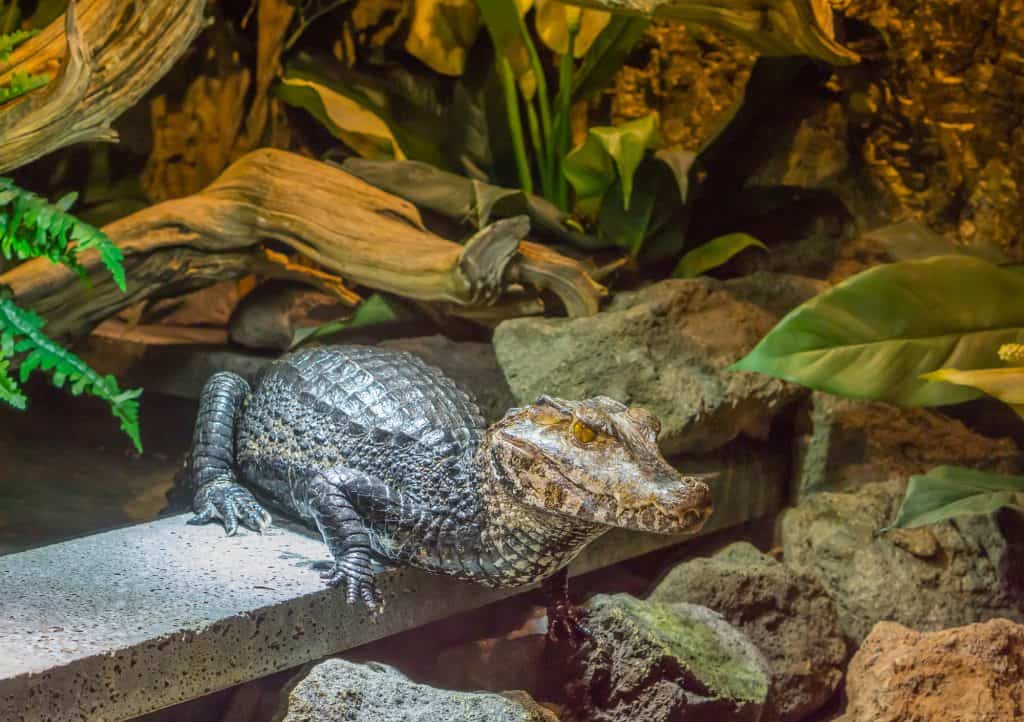
Dwarf Caiman Diet
Caimans eat different types of fish, meat, invertebrates, rodents, and birds.
The bulk of their diet must be complete birds and rodents. We DON’T recommend feeding reptiles live prey due to safety problems.
You may need to supplement their diet with calcium if they don’t have access to bones of small prey carcasses.
They also require an additional supplement mixture of vitamins and minerals.
It’s a good idea to add a change to their diet every third or fourth feed. You need to feed caimans every three to four days, depending on their growth.
You can estimate caiman growth according to the fullness of the tail base, sides of the abdomen, and the neck.
These areas shouldn’t bulge or look hollow. If they bulge, you’re overfeeding. If they’re hollow, you’re underfeeding.
Dwarf Caiman Handling
Caiman handlers should have a lot of experience, or professional supervision. Caimans are more likely to cause serious injuries when being handled by inexperienced owners.
Minimal handling is preferable due to the stress it causes. Caimans hiss and inflate their body if threatened.
Use tongs when feeding to maintain a safe distance from the animal.
It’s possible to target train caimans. Some experts advise that these species can recognize people.
Never handle a caiman while you’re alone.
Protect your hands with thick gloves and tape the caiman’s mouth shut if you’re going to pick it up.
Dwarf Caiman Health Information
The dwarf caiman has many specific needs! Health issues can occur if these needs aren’t satisfied.
Prevention is better than cure. Pay proper attention to the hygiene and physiological needs of this unique reptile!
The following sections will cover some of the potential health problems for this species.
Hypothermia
Hypothermia is the result of water or an enclosure with low temperatures. A caiman suffering from hypothermia moves to the side when swimming and can even drown.
Other signs include:
- Lethargy
- Appetite loss
- Decreased feces
You must correct the temperature immediately and have a specialist veterinarian examine the caiman.
Dermatological Diseases
Caimans enjoy scratching their bodies using their rear legs.
If they start doing so constantly, check:
- The water quality
- Enclosure climate
- Whether parasites are present
- If anything is stressing the caiman
If any of these things aren’t optimal, it can lead to fungal and bacterial infections.
Dernatophilosis is a bacterial infection that manifests as ulcerated or brown or red areas on the skin. It’s normally of hygienic origin and a veterinarian can treat it.
Other skin infections may also display symptoms like a rash, itchy skin, or blisters.
You can prevent dermatological issues by maintaining adequate cleanliness and an appropriate enclosure climate.
Respiratory Diseases
Respiratory diseases are infections of the lungs and breathing passages.
They manifest as:
- Lethargy
- Weakness
- Appetite loss
- Abnormal behavior
- Discharge from the nose or eyes
Viruses, bacteria, and fungi cause these diseases, and they require specialist veterinary treatment.
These problems can be fatal if left untreated.
Neurological Diseases
Neurological diseases are the result of low glucose levels or an increase in ammonia levels and require specialist veterinary treatment.
They exhibited as:
- Tremors
- Lethargy
- Refusal to eat
- Lack of coordination
- Abnormal head position
- Strange swimming behavior
Ammonia levels can be controlled using a bacterial system and air pump in the water.
Why Is My Dwarf Caiman Not Eating?
Young caimans sometimes reject food due to stress.
To prevent this, avoid handling and disturbing them around feeding time.
You can use live crickets in an attempt to engage a feeding reflex. You should also avoid having people moving near the enclosure during feeding time.
Sometimes a pair of caimans feed better together when compared to a solitary animal.
You can also add more ‘hiding’ areas and increase the temperature. If all else fails, consult a specialist reptile veterinarian.
Chicago Exotics Animal Hospital is a specialist center taking calls for more information.
Dwarf Caiman Price
As hatchlings, caimans cost between $200 and $400.
You should consider the husbandry costs of caimans before buying one.
Adequate water filtration, light, food, maintenance, and veterinary treatment are expensive considering their life expectancy.
In their lifetime, caimans can cost thousands of dollars to care for. You’ll also need to pay an administrative fee for any necessary permits and an increase in home insurance premiums.
Before buying a caiman, ask yourself if you can commit the time, space, and finances that a caiman needs.
People often release caimans into the wild when they can’t manage their size and the related financial burden.
Such acts endanger people and the ecosystem. Always ensure you can care for the animal before buying it.
If you find that you can’t care for your caiman, contact a sanctuary that’s equipped to deal with the animal.
Where Can I Buy Cuvier’s Dwarf Caiman?
You can choose to rescue an individual from a sanctuary, or visit a reptile expo.
It’s important to only buy captive-bred reptiles. Captive breeding protects wild animals and breeds sustainability.
Animals that have been taken from the wild are more prone to health problems and injuries.
You’re most likely to find caimans at specialist pet centers. It’s important to ensure that the store is reputable before you buy.
You can check the internet to assess the reputability of any stores or breeders before buying from them.
You can buy dwarf caimans online but this doesn’t allow you to check the animal beforehand.
Could You Safely And Correctly Enjoy Cuvier’s Dwarf Caiman As A Pet?
The size, needs, and dangers of caimans as pets mean that they’re unsuitable for most reptile enthusiasts.
If you want a reptile, why not try a less complicated species? We have care guides for animals like bearded dragons, and Russian tortoises.
A large proportion of baby caiman owners abandon their animals after they increase in size.
Once they reach the adult size they’re unlikely to find homes in zoos, aquariums or become rescued.
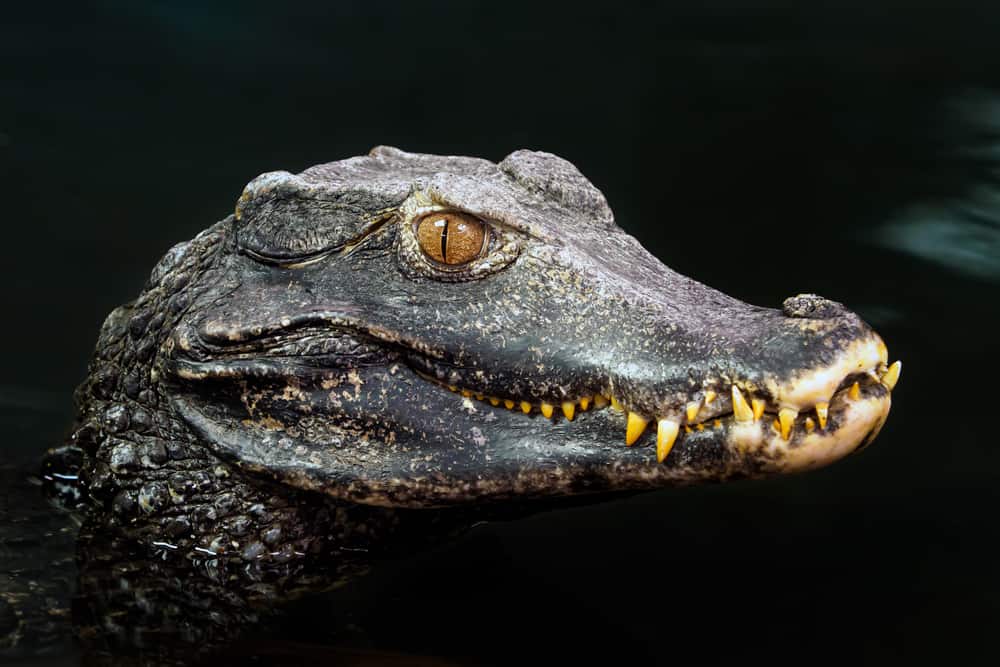
Perhaps it’s preferable to visit and learn about these interesting prehistoric creatures in the zoo after all!
Luckily there isn’t a lack of options for those eager to have a reptilian pet!
Have you or someone you know had an encounter with these interesting species? Tell us about it in the comments section below!
